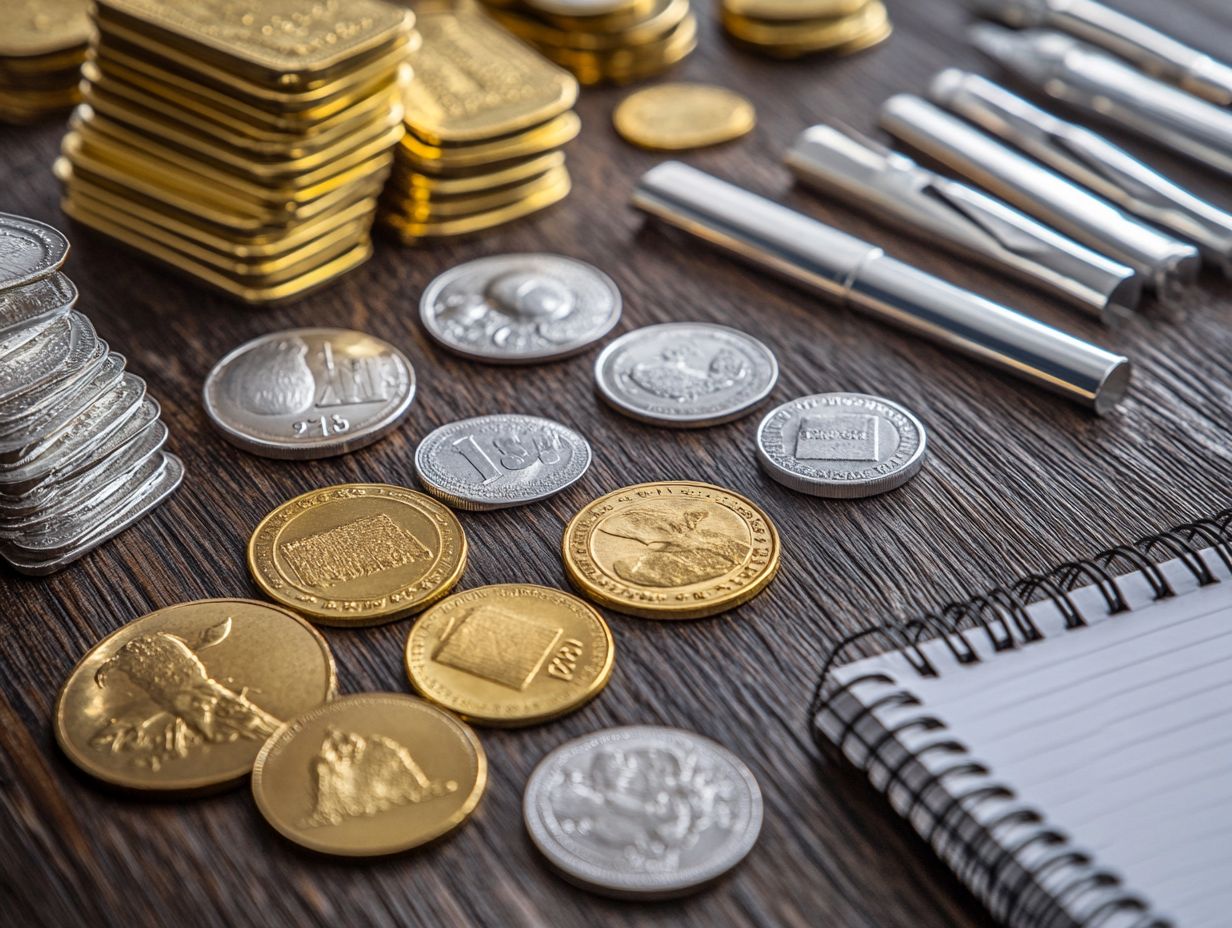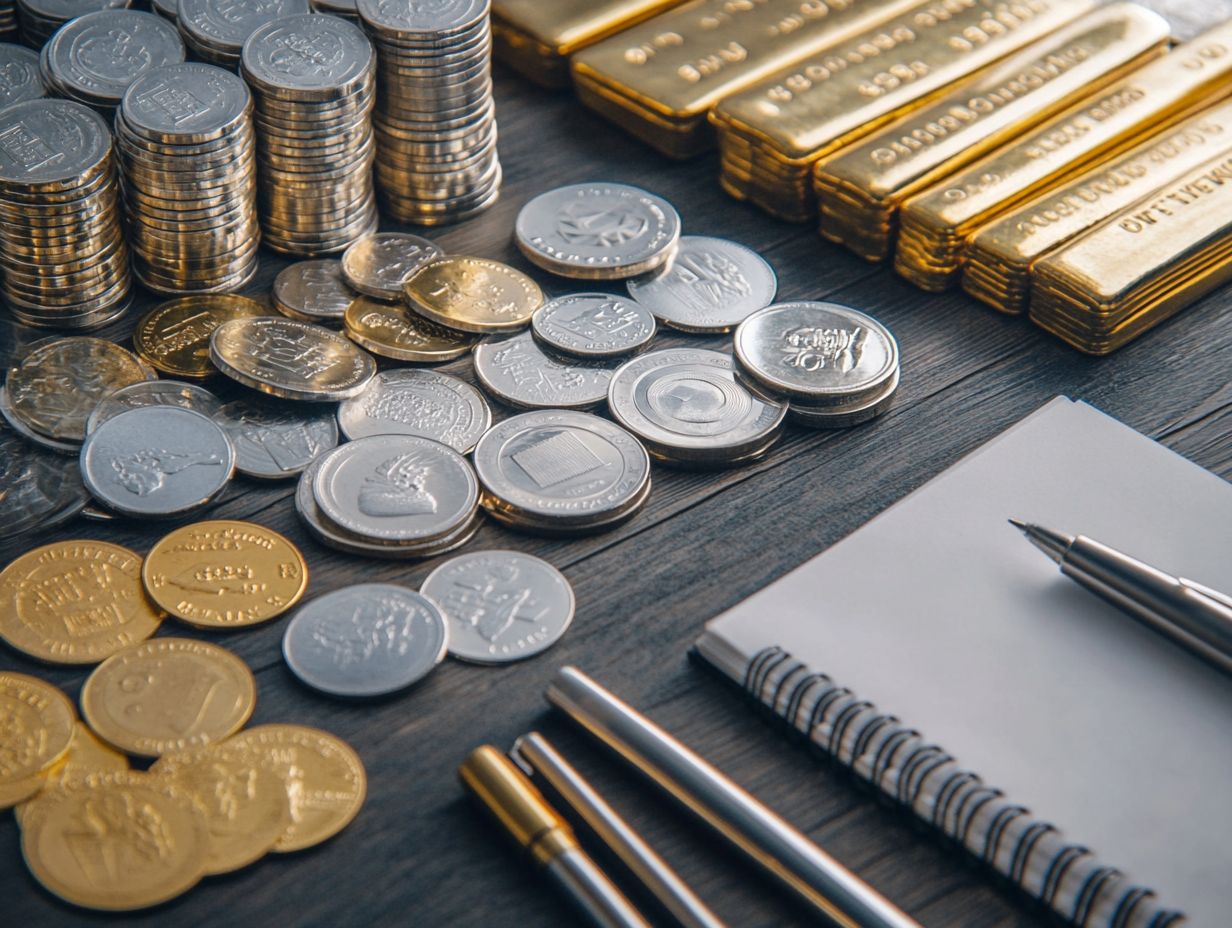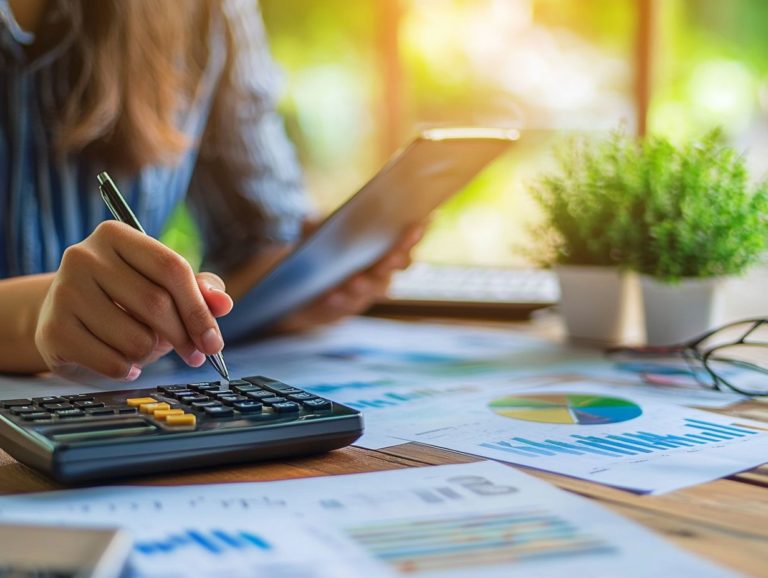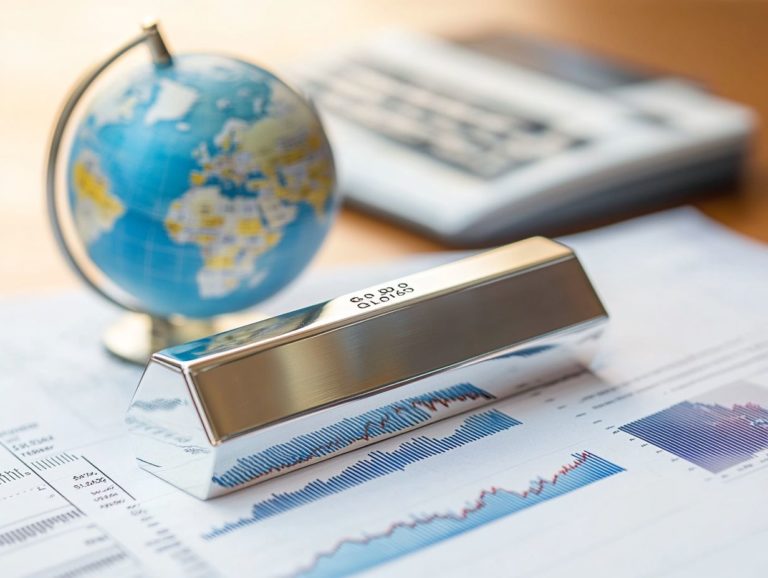How to Diversify Your Precious Metals Portfolio
Investing in precious metals serves as an astute strategy for safeguarding your wealth and hedging against economic uncertainty.
This guide will illuminate the various types of precious metals, highlighting their distinct characteristics and underscoring the critical importance of a diversified portfolio. You’ll discover the myriad benefits of diversification, delve into different investment avenues, and gain insight into essential factors to consider, such as risk tolerance and market trends.
Armed with practical tips for successful diversification, you will be well-prepared to make informed decisions and refine your investment strategy for optimal results.
Contents
- Key Takeaways:
- Understanding Precious Metals
- Why Diversify Your Precious Metals Portfolio?
- Ways to Diversify Your Precious Metals Portfolio
- Factors to Consider When Diversifying
- Tips for Successful Diversification
- Frequently Asked Questions
- What is the importance of diversifying my precious metals portfolio?
- How can I diversify my precious metals portfolio?
- Does diversifying my precious metals portfolio mean equal distribution?
- Why should I consider investing in precious metals?
- Can I diversify my precious metals portfolio without physically owning the metals?
- What role does timing play in diversifying my precious metals portfolio?
Key Takeaways:

- Diversifying your precious metals portfolio allows for a more balanced and resilient investment strategy.
- Investing in different types of metals and exploring different markets can help mitigate risk and maximize returns.
- Don t overlook your risk tolerance it’s key to your success when diversifying your precious metals portfolio.
Understanding Precious Metals
Understanding precious metals like gold, silver, platinum, and palladium is essential for you as an investor. These metals provide a reliable hedge against inflation, deliver liquidity, and serve as a safe haven during times of economic uncertainty and market turbulence.
You should consider buying physical metals, such as coins and bars, or explore ways to invest like Exchange-Traded Funds (ETFs) and mutual funds to effectively diversify your assets.
Types of Precious Metals and Their Characteristics
The primary types of precious metals include gold, silver, platinum, and palladium. Each boasts unique characteristics that shape its market appeal and investment value.
Gold has long been celebrated for its historical role as currency and a symbol of wealth. It serves as a safe haven during times of economic uncertainty. To enhance your investment strategy, consider how to diversify with precious metals. Silver, on the other hand, straddles the line between precious and industrial metal. Its demand in technology and renewable energy continues to rise.
Platinum, rarer than gold, captures attention not only in the jewelry market but also in catalytic converters, making it particularly valuable in the automotive sector. Meanwhile, palladium has experienced a surge in demand as nations implement stricter emissions regulations, enhancing its investment potential.
Collectively, these metals offer both numismatic allure and raw value, ensuring their significance in a well-rounded investment portfolio.
Why Diversify Your Precious Metals Portfolio?
Diversifying your precious metals portfolio is crucial for crafting a resilient investment strategy. It serves as a hedge against inflation and protects your wealth during times of economic uncertainty.
By thoughtfully including a blend of gold, silver, and other precious metals in your investment mix, you can enhance your returns while minimizing the risks tied to market fluctuations.
Benefits of Diversification
The benefits of diversifying your precious metals investment portfolio are numerous and compelling. You enhance wealth preservation, safeguard against market volatility, and secure a reliable safe haven during economic downturns.
By incorporating a variety of precious metals like gold, silver, and platinum, you can significantly reduce your risk exposure while capitalizing on market fluctuations. This strategic mix minimizes the potential for losses during economic uncertainty while opening up pathways for higher returns. To learn more about effective strategies, check out how to build a resilient precious metals portfolio. Each metal responds differently to changing market conditions.
Improved liquidity in these assets grants you more flexible trading opportunities, making it easier to seize market movements over the long term. Altogether, these advantages create a robust investment strategy that protects against potential downturns while maximizing your growth potential. This aligns seamlessly with your long-term financial goals.
Are you ready to elevate your investment game? If you’ve recently come into possession of some valuables, you might be wondering what to do with inherited precious metals. Start diversifying your portfolio today for a secure financial future!
Ways to Diversify Your Precious Metals Portfolio

You have several effective avenues to diversify your precious metals portfolio. Consider direct investments in physical metals like coins and bars, which provide tangible assets. Alternatively, explore ETFs, mutual funds, and mining stocks for a more fluid approach.
Each of these investment strategies presents unique advantages tailored to your individual risk tolerance and investment objectives.
Investing in Different Types of Metals
Investing in various types of precious metals, such as gold, silver, platinum, and palladium, is essential for achieving effective portfolio diversification.
These metals have historically displayed distinct performance metrics and behaviors. This makes them appealing options for investors like you who aim to mitigate risk while boosting potential returns.
Gold, often viewed as a safe haven asset, typically appreciates during economic downturns. On the other hand, silver tends to exhibit a more volatile price history, closely tied to both industrial demand and investment sentiment.
Platinum plays a critical role in the automotive industry. Palladium is vital for catalytic converters. These metals reveal fascinating market trends shaped by technological advancements and regulatory changes.
By understanding how these metals complement one another, you can create a more strategically balanced investment approach that adapts to varying market conditions.
Exploring Different Markets
Exploring different markets for precious metals can significantly enhance your investment portfolio, especially during times of market volatility and shifting economic landscapes.
By diversifying your investments in assets like gold, silver, and platinum, you can better navigate the unpredictable financial terrain. To understand the role of precious metals in a portfolio, online platforms such as US Gold Bureau and Provident Metals offer convenient access to purchase these valuable commodities, enabling you to make informed decisions with ease.
These platforms also provide real-time pricing and personalized advice. This allows you to determine the ideal moments to buy or sell based on prevailing market trends.
Keep in mind that factors like inflation, global political issues, and currency fluctuations can impact the prices of these metals. This underscores the importance of staying informed and adapting your strategies accordingly.
Factors to Consider When Diversifying
You must consider a few key factors to maximize your investments! Pay attention to your risk tolerance, define your investment goals, and stay informed about prevailing market trends that could signal economic uncertainty.
Each of these elements will play a crucial role in shaping your strategy. This ensures your investments align with your financial aspirations.
Risk Tolerance and Investment Goals
Understanding your risk tolerance and establishing clear investment goals are essential steps in crafting a well-rounded precious metals portfolio. These elements become particularly vital when considering investments in precious metals like gold, silver, and platinum, which are often subject to significant market fluctuations.
Your willingness to endure potential losses without liquidating your investments plays a crucial role in determining how to spread your investments. Collaborating with a financial advisor can provide you with tailored insights that align with your personal risk profile and long-term aspirations.
These advisors help you navigate the complexities of market trends. They offer guidance on the optimal types and amounts of precious metals to include in your investment mix, such as how to use gold to diversify your portfolio, ensuring that your decisions are made thoughtfully and strategically.
Market Trends and Economic Conditions

Market trends and economic conditions are crucial in shaping your investment strategies for precious metals. They significantly impact liquidity and overall performance.
Understanding the evolution of these trends especially in light of historical events like the 2008 financial crisis can provide valuable insights. The crisis underscored how precious metals often serve as a safe haven during turbulent times, leading to increased demand and significant price surges when equities falter. For those interested in investing, learning how to build a precious metals portfolio can be crucial.
By analyzing these patterns, you can better navigate the complex market landscape and make informed decisions that capitalize on both current and anticipated market shifts. Staying attuned to the dynamic interactions between economic indicators and precious metal valuations will enhance the resilience of your investment portfolio. If you’re considering investments in precious metals, knowing how to liquidate precious metals is crucial for future planning.
Tips for Successful Diversification
Successful diversification of your precious metals portfolio relies on diligent research, consistent portfolio reviews, and effective consultations with a financial advisor. This approach ensures that your investments remain aligned with your overarching strategy, optimizing your potential for growth and stability.
Research and Consultation
Thorough research and consultations with a financial advisor are essential for optimizing your precious metals investment strategies.
As you explore research methods, such as numerical assessments and market trend evaluations, you’ll gain a comprehensive understanding of market dynamics. Online platforms, academic journals, and industry reports serve as invaluable resources, providing insights into the historical performance and future projections of gold, silver, and other precious metals.
Engaging in forums and attending workshops can significantly enhance your knowledge. Expert guidance helps you tailor personalized investment plans. This multifaceted approach strengthens your decision-making and fosters confidence as you navigate the complexities of managing your precious metals portfolio, including understanding how to set investment goals for precious metals.
Regular Portfolio Review and Adjustments
Regularly reviewing your portfolio keeps your investments sharp and ready for market changes! These evaluations help identify underperformers, allowing necessary reallocations to optimize overall performance.
It s essential to monitor various metrics such as return on investment, volatility, and diversification levels. These metrics reveal the underlying health of your investment choices.
By staying attuned to external factors like economic indicators, geopolitical events, and shifts in supply and demand you can make timely adjustments that enhance your strategy. Regular reassessments of your positions empower you to seize opportunities arising from market fluctuations while effectively mitigating risks linked to unfavorable trends.
Frequently Asked Questions
You might be wondering about the significance of diversifying your precious metals portfolio. Here are some common questions:
What is the importance of diversifying my precious metals portfolio?

Diversification is crucial in any investment portfolio, including precious metals. It helps mitigate risks and potential losses by spreading your investments across different types of assets.
How can I diversify my precious metals portfolio?
There are several ways to diversify your precious metals portfolio. You can invest in various types of metals, such as gold, silver, platinum, and palladium. Additionally, consider different forms of metals, such as bullion, coins, or stocks of mining companies.
Does diversifying my precious metals portfolio mean equal distribution?
No, diversifying does not necessarily mean having an equal distribution. You can allocate your investments based on your risk tolerance and financial goals. It is important to have a balanced approach and not put all your eggs in one basket.
Why should I consider investing in precious metals?
Precious metals are known as safe-haven assets. This is especially true during economic uncertainty.
They hold inherent value and are not impacted by inflation or stock market changes. Investing in them can stabilize your portfolio.
Can I diversify my precious metals portfolio without physically owning the metals?
Yes, you can diversify your precious metals portfolio without holding the metals physically. Investing in ETFs or mutual funds backed by precious metals is a great option.
This method offers diversification along with convenience for trading.
What role does timing play in diversifying my precious metals portfolio?
Timing is vital for diversifying your precious metals portfolio. Regularly review and rebalance your investments to keep them diversified.
Consider market trends and economic conditions when making investment choices.















